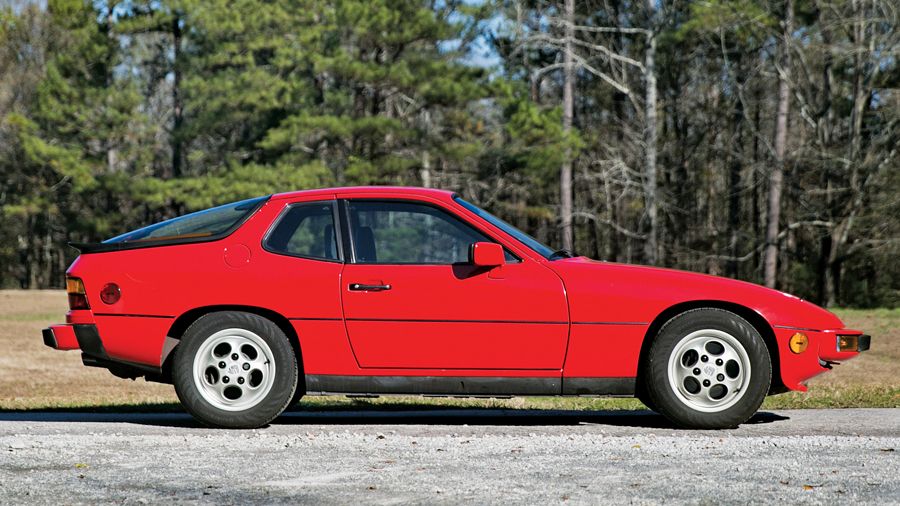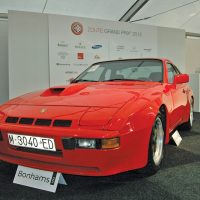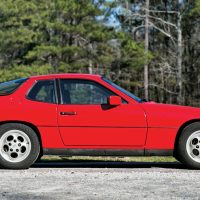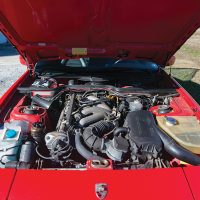
As a rule, it’s the overlooked cars that make the best Affordable Classics. That’s certainly the case with the Porsche 924. The more-developed 944 that came along later has completely overshadowed Porsche’s first water-cooled car.
It’s well past time to take another look and find the appeal and the value in one of the last affordable Porsches.
An inauspicious beginning
When the 924 arrived for the 1977 model year, it replaced the lackluster 914 2.0 and the 912E as Porsche’s entry-level offering.
The U.S.-spec 924 offered 94 horsepower, which was 10 more than the last 914 or 912, but it carried no risk of cannibalizing sales of the 157-hp 911.
The biggest news was obvious. For the first time ever there was a Porsche with a wet engine in the front. However, it was a tepid Audi-sourced 2.0-liter 4-cylinder. Would existing Porsche customers accept such an apostate design, or would this sports car attract new customers to the brand?
The first 924s arrived with a 4-speed manual or a 3-speed automatic transaxle, located in the rear. The transaxle design gave the 924 excellent balance, but the car was also fitted (some might say saddled) with rear drum brakes.
The first 924s struggled to a 0–60 mph time of about 12.5 seconds. With ho-hum performance and enough Audi rings stamped on the car to question its parentage, the 924 seemed destined to remain in the shadow of “real” Porsches.
Management got the message early, and before 1977 was over, the 924 was updated to a higher compression ratio that yielded 110 horsepower and a 0–60 mph time of about 11.2 seconds, according to Porsche’s sales literature. A 5-speed transaxle became optional during 1978 and was standard for 1979.
The 924 Turbo
The first 924 Turbo (931) cars also appeared in 1979, offering 143 horsepower and a 9.3-second 0–60 mph time according to Porsche’s sales brochure. A spoiler and a few other cues distinguish the Turbo models from the basic 924. A mid-cycle refresh for 1981 boosted engine output to 149 horsepower.
For those looking for the ultimate 924, there was a limited-production turbocharged 924 Carrera GT produced in 1980 for the 1981 model year. Only 406 were made, and these included wider front fenders like a 944 and some plastic flares to cover larger wheels and tires in the rear. The engine produced 210 horsepower, and special brakes and suspension were also included. None of the Carrera GTs were ever officially imported to the United States, but they’re a mainstay of the 924 collector scene today — and can fetch six figures at auction.
The revival
In 1983, Porsche brought out the 944 and discontinued the 924 in America — while continuing 924 production for Europe. The 924 came back for a revival in 1987–88 as the 924 S. This car featured the naturally aspirated 2.5-liter engine and drivetrain from the 944, boasting 147 horsepower in 1987 and 158 horsepower in 1988.
The 1987 Porsche sales brochure stated a 0–60 mph time of 8.3 seconds for the 924 S, and the 1988 documentation claimed 8.0 seconds. Over the course of the two-year revival, Porsche sold 9,137 units of the 924 S in America.
Which 924 should you buy?
As a rule, newer is better with cars from the 1970s and 1980s.
There’s no reason to think a 924 would be an exception to that rule. With each passing year, the 924 got better. More engine power, better brakes and tougher transaxles all came along. The 924 S, with its well-developed drivetrain, is the best choice of all.
Because most 924s have been neglected over the decades, finding the right car is critical. Turbo models should be carefully checked out before purchase. Asking prices can range as high as $5,000 for a well-kept 924 on the general market — and more than that for a Turbo. It bears saying that paying a low price for any 924 may be the worst decision you make all year.
Why should you want this car?
The rap on the 924 was always that it was far more expensive than its performance warranted.
Contemporary small-bore competitors, such as the Alfa Romeo Spider, Fiat 124 Spider, Mazda RX-7 and Datsun 280ZX offered comparable performance for dramatically less money.
Yet time has been extremely kind to the 924 design. It looks better than a 280ZX today, and simple survival often bestows a respectability that wasn’t forthcoming when a car was new.
There’s also good reason to think that Porsche intentionally and substantially understated the 924’s performance. Car & Driver magazine got a basic 924 to 60 mph in 8.8 seconds in 1979, and Road & Track got a 1980 924 Turbo up to speed in 7.7 seconds in their instrumented tests, shaving several seconds off the official times.
Looking through the SCM Platinum Auction Database, sales of basic 924s are few, because those are Craigslist cars rather than auction material.
Later 924 S models in good shape can range from $7,370 (SCM# 6799790) up to $34,416 (SCM# 6853691). Realistically, you don’t want to buy anything but a 924 S — unless you’re prepared to write a big check for a Carrera GT.
What you’ll get for your money is a sports car that most people haven’t seen on the road in decades. Even the high-priced 924 S models are affordable enough to make them a fun daily driver or a track-day car. Plus you still get that Porsche badge on the hood, and that’s worth something. ♦




